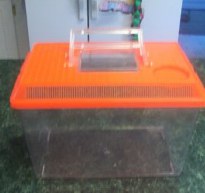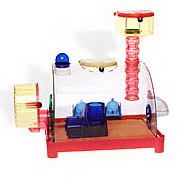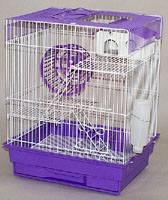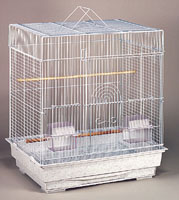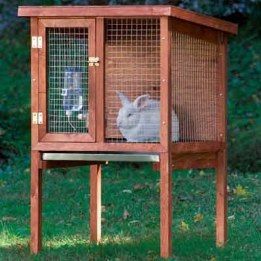Cage
The cage will be your most important supply decision and probably the most expensive thing you buy for your rats. It will be where your rats spend a lot if not most of their time. It needs to be big enough for them, safe, easy to clean, inescapable (part of safety), conductive to good health, long-lasting, good for rats' habits and emotional needs, and in your budget.
Basic requirements:
Size: At least 2 square feet floor space (shelves count) for one, and 1 to 2 sq. ft per rat in a group or pair. Allow at least 10" vertical room, maybe more for climbing or for toys (like wheels). A very helpful tool for determining how big a cage you need (or how many rats can live comfortably in one you have) is the Cage Calculator.
Wire Spacing/Openings: 1" x 1" or 1/2" x anything works for juveniles and older. Wider spacing can work for adult males.
Here's a run-down of housing options and how they meet or don't meet these concerns:
 Aquariums
Aquariums
Size: 15 gallons long or bigger is needed for one to two rats. (A 10 gallon can work for a single rat with lots of outside playtime or a sick rat.)
Escapes: With a secure mesh lid, escapes are nearly impossibly for any rat.
Safety: If cage falls, it will almost certainly kill or seriously injure rats. Glass walls and weight make them fairly safe from cat claws. Single level is good for rats that have seizures or are aged, and there is nothing to get feet caught on or fall from.
Cleaning: Aquariums need cleaned more often due to lack of ventilation. Glass is easy to clean and disinfect. Larger aquariums are a little heavy and awkward to handle for maintenance.
Healthy: Even with a mesh lid, aquariums can have poor ventilation, and can quickly overheat if exposed to sunlight. They keep out drafts excellently and are good for sick, elderly, or hairless rats. (A heating pad can be placed under half the tank in cool weather.)
Rat-Friendly: Not conductive to rats' natural behavior. They can't climb and have to live on their litter. Provide lots of climbing toys. Good for special needs rats who may not be able to climb or get around well. Rats also are happier with more areas open to the smells and activities of the room.
Long-lasting: It doesn't rust, and there are no wires to get bent or chewed. A glass aquarium can last a LONG time if you take care not to let it get cracked or broken.
Price: Unfortunately larger aquariums are expensive and good lids are even more so. 10 gallon aquariums are very cheap, around $9 each and you can modify them by making a wire cage top or connecting two with homemade lids and/or PVC pipes.
 Plastic Tanks/Cages
Plastic Tanks/Cages
Size: Even the largest plastic tank made is abusively small for a rat. You can use Sterilite bins to build a cage. Modular hamster cages are not suitable for rats. All their openings and shelves are too small.
Escapes: A determined rat can easily chew through plastic.
Safety: Very safe cage as long as openings are secure. Excellent as transport cages for trips to the vet or shows. Easily tipped over by cats, though.
Cleaning: Plastic holds smells more strongly than glass. Otherwise, like a glass tank.
Healthy: Same as glass tank.
Rat-Friendly: Same as glass tank.
Long-lasting: Don't count on it. Plastic gets scratched, chewed, and cracked.
Price: Usually very cheap with the exception of some fancy hamster cages. It's nice to have one around as a transport cage.
 Wire Cages
Wire Cages
Size: Wire cages come in the widest variety of shapes and sizes. Look for at least 2 ft wide, 1 ft deep, and 10 inches tall or 1 ft wide, 1 ft deep and 2 feet tall with a full level halfway up for one or two rats. Buy the biggest cage you can afford and have room for.
Safety: Watch out for sharp edges and long drops. And watch for mesh shelves that could catch feet and cause injuries.
Cleaning: There is much better ventilation, so cage may not need cleaned as often. Cleaning may require a hose or a spray down in the bathtub. Rats also may push litter out of the cage, making your job a little harder.
Healthy: A nest box of some sort is needed so rats can get away from drafts. The good ventilation keeps the cage cool in summer and doesn't allow a hazardous buildup of ammonia.
Rat-Friendly: Definitely. Wire cages permit climbing and adding all sorts of wheels and hanging chew toys and other things. Rats can sleep on higher levels off their litter.
Long-lasting: Some are built to last. Others may be easily bent or rust.
Price: Buy used cages or from supply warehouses to get a cheap cage. Larger cages can be quite expensive but reasonable compared to a similar sized aquarium.
If at all possible, buy a cage made for rats. As rats are increasing in popularity, rat cages are becoming more widely available from a variety of sources. See below for some other varieties of wire cages you may run into.
 Galvanized or Coated?
Galvanized or Coated?
The only advantage of a galvanized cage is that it is cheaper than a cage made of powder coated or PVC coated wire. Galvanized wire holds odors badly and even the best scrubbing with vinegar can't fix the problem. Uncoated wire shelves can irritate or cut feet and cause bumblefoot (a painful swelling that often can't be cured). If at all possible, get coated wire. Powder-coating and PVC coating are both fine and easy to clean.
 Hamster Cages
Hamster Cages
In general, hamster cages aren't suitable for rats. They are usually far too small and have tiny shelves and often tubes or accessories that rats will outgrow within just a couple months from when they are born, and within a few weeks of when you buy them. Some very large hamster cages may work but make sure the shelves are generous and remove all wheels and hamster-sized accessories. Remember that adult rats are 8 to 10 inches long not counting their tails, and they need room to stretch, stand, climb, and run. If the cage has a wire or plastic grate on the floor, remove it. (The cage shown is too small!)
 Bird Cages
Bird Cages
Because birds fly, hop, and use perches, their cages aren't built with a rat in mind. Since these cages are widely available and you may acquire one secondhand, you can convert one to a rat cage by removing the perches and adding shelves and things to climb on. Something else you need to fix is any doors that slide open. Rats can easily open a sliding door, so you'll need to make a hook of some kind. (Paper clips work.) Another disadvantage is that most have vertical bars which rats can't climb. That removes one of the advantages of wire cages. Rats do love to climb. As for size, cages made for cockatiels or flight cages for small birds are large enough for rats with proper bar spacing. (Use the requirements stated above.) If there is a wire or plastic grate on the floor, you will need to remove it so the rats can walk on a solid surface.
 Ferret Cages
Ferret Cages
Ferret cages are great for rats in most respects. They are a good size and are made for climbing and play. They are made for easy cleaning, because ferrets can be messy. Many are made specifically for attachment of toys and add ons. A "starter kit" for ferrets can be good for rats, since they often include a hammock, a litter box, a large water bottle and food bowl, and toys suitable for rats. The only big disadvantage is the spacing is often too wide, suitable only for adult males or large adult females. Many also have wire shelves. Any shelves with wider than 1/2" x 1/2" spacing and/or are bare wire need to be covered with plastic or linoleum. As usual, remove any wire mesh floors. (The cage shown here has solid plastic shelves and is a castle for six adult (8 weeks +) male rats.)
 Wooden Cages/Hutches
Wooden Cages/Hutches
Size: Usually made for rabbits, size is not a problem. Just go by the general guidelines.
Escapes: Rats can chew through wood. It's one of their favorite things to chew!
Safety: Possible splinters. Wood and wire cages are sturdier than wire alone. Otherwise like a wire cage. Hutches with wire floors can cause bumblefoot, and because rats cannot be kept outside, it doesn't work well anyway.
Cleaning: Impossible. Wood is not easy to clean and impossible to really disinfect.
Healthy: Not at all. Wood can be full of pests and parasites. Many soft woods (cedar and pine included) contain oils that cause respiratory problems and liver damage. Treated wood may have additional dangerous chemicals. Wood holds ammonia indefinitely and can make rats sick.
Rat-Friendly: Although wood seems "natural," cages made of wood and wire have no advantages over wire cages.
Long-lasting: Wood will deteriorate over time, and it will soak up urine.
Price: Building a cage with scrap wood can save money, but commercial hutches are no cheaper than wire cages.
 Homemade Cages
Homemade Cages
Cage built by Ashley for 3 adult males.
Size: Go by guidelines and build your cage to fit your home.
Escapes: Homemade cages can be easily escaped if your design isn't flawless. Any access to the cage should require some manipulation or strength.
Safety: A poorly built cage can injure or kill a rat! Make sure nothing can fall, there are no sharp parts or splinters, no toxic paint is used in the materials and that the cage cannot be easily tipped over.
Cleaning: Make sure the litter tray/base is deep or the rats are trained to use a litterbox. Use materials that are easily wiped clean like coated hardware cloth, wire shelving, and/or strong plastic.
Healthy: The cage needs to have good ventilation, which means at least one side made of a wire or mesh material. You can add more cozy closed in sections or use a nest box like you would in a wire cage. Avoid bare metal or wood in the construction.
Rat-Friendly: Making a cage yourself allows you to plan for rats' needs. Make sure there are places where they can climb and room for lots of toys. Bars should be horizontal.
Long-lasting: A well-built cage can last a long time.
Price: Building a good cage will cost as much as buying a good one unless you already have some of the major components or can get them secondhand.
Here are some links to blueprints for rat cages:
Recommended products:

